Step into the ancient battlegrounds of Gaza, where biblical wars reveal a history as captivating as it is complex—discover more inside.
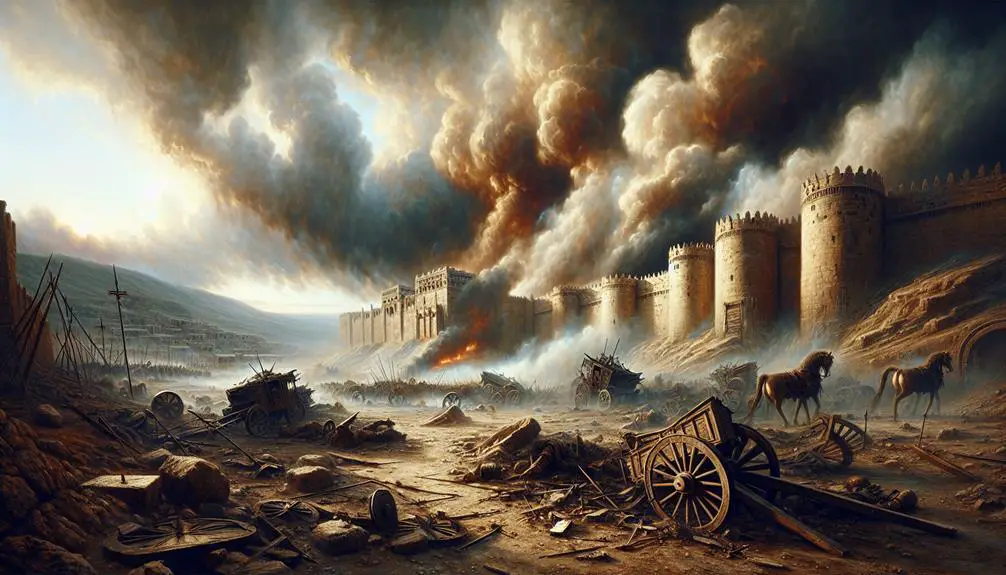
Gaza War in the Bible
Have you ever wandered through the pages of ancient texts, only to find yourself amidst the tumultuous battles of Gaza mentioned in the Bible? You're not alone in your curiosity.
As you explore the historical context of Gaza, from Samson's rebellion to the Babylonian invasion, you'll uncover a tapestry of conflicts that shaped the course of history.
The siege of Gaza, the Philistine confrontation, and the legendary battle between David and Goliath are just the tip of the iceberg. But what lies beneath the surface of these storied battles, and how do they influence our understanding of ancient and modern conflicts?
Join the conversation and uncover the layers of history that have left their mark on the sands of Gaza.
Key Takeaways
- Gaza's strategic location made it a central battleground in biblical times.
- Samson's rebellion against the Philistines is a pivotal story of resistance in Gaza.
- Biblical accounts of the Siege of Gaza highlight its importance and the innovative tactics employed.
- The narratives reveal the cyclic nature of violence and the struggle for autonomy in the region.
Historical Context of Gaza
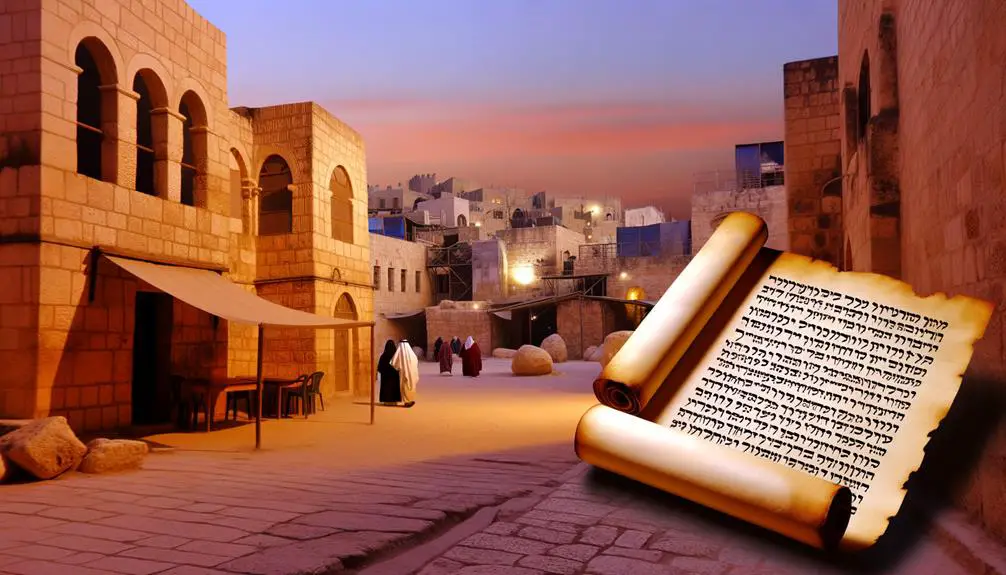
The city of Gaza, a pivotal crossroads of ancient civilizations, has a history steeped in conflict and cultural exchange, tracing back to the earliest records of human settlement in the region. You'll find that Gaza's origin is deeply intertwined with the strategic location it occupies, bridging continents and facilitating trade routes that have been vital for commerce, culture, and conflict throughout history.
Gaza served as a gateway between Egypt and the Levant, positioning it as a crucial hub on the ancient world's trade routes. This geographical advantage meant that control over Gaza was often contested by empires eager to dominate these lucrative paths. The city's prosperity and significance were, in part, a direct result of its access to and control over these trade routes, which carried spices, textiles, and other goods between Africa, Asia, and Europe.
Analyzing Gaza's historical context, you're confronted with a narrative of a city that was perpetually at the heart of ancient geopolitical struggles. Its strategic importance made it a focal point for invasion and conquest by successive empires, including the Egyptians, Philistines, Babylonians, and later, the Romans. Each of these powers left an indelible mark on the city's cultural and social fabric, contributing to the rich tapestry of Gaza's history.
Understanding Gaza's origin and its role in ancient trade routes provides a comprehensive backdrop against which the complexities of its historical conflicts can be better appreciated. This perspective is crucial for unpacking the layers of Gaza's past, offering insights into the broader narrative of the region's history.
Samson's Rebellion
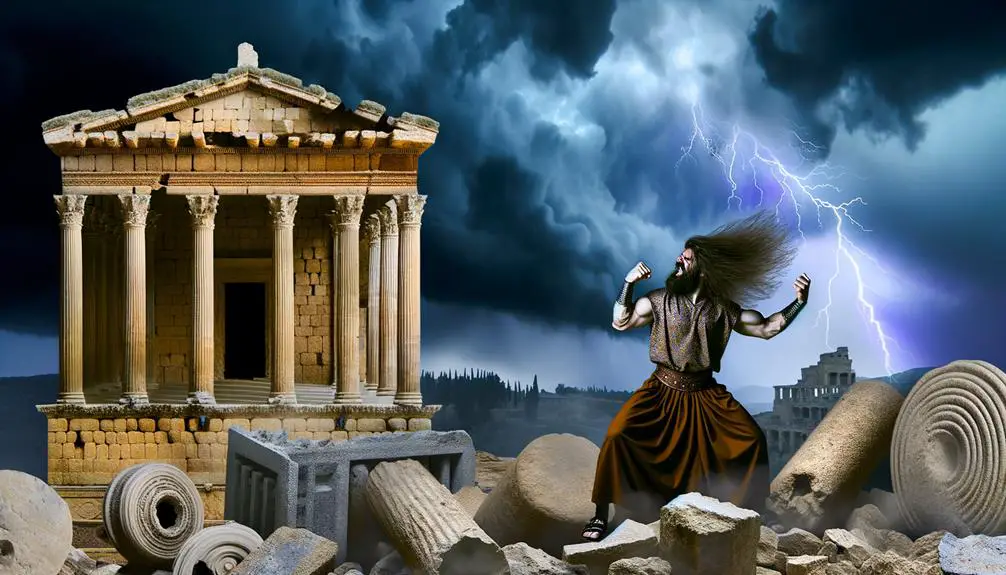
Amid the historical tapestry of Gaza's strategic significance and cultural exchanges, Samson's rebellion stands out as a pivotal moment of defiance against Philistine domination, reflecting the complex interplay of power and resistance in the region. You'll find that Samson's narrative isn't just a tale of personal vendetta but a symbol of the struggle for autonomy faced by the Israelites under Philistine rule. His extraordinary feats, attributed to his unparalleled strength, serve as a testament to the indomitable spirit of resistance against oppression.
Samson's strength, however, wasn't an unbridled force. It was contingent upon his adherence to the Nazirite vow, which included abstaining from cutting his hair. This vow not only signified his commitment to God but also acted as the source of his strength. Delilah's betrayal, then, becomes a focal point in understanding the dynamics of power and vulnerability. Her deception led to the cutting of Samson's hair, effectively stripping him of his strength and, by extension, his ability to resist Philistine domination.
The aftermath of Delilah's betrayal and the loss of Samson's strength underscore the precarious balance of power and the ease with which it can be tipped through subterfuge. Moreover, Samson's eventual capture and his final act of defiance, which led to his death and the death of many Philistines, highlight the cyclic nature of violence and the lengths to which individuals will go to resist subjugation.
In analyzing Samson's rebellion, you're confronted with the themes of strength and betrayal, which illuminate the broader struggle for power and identity in the context of Gaza's tumultuous history.
Siege of Gaza
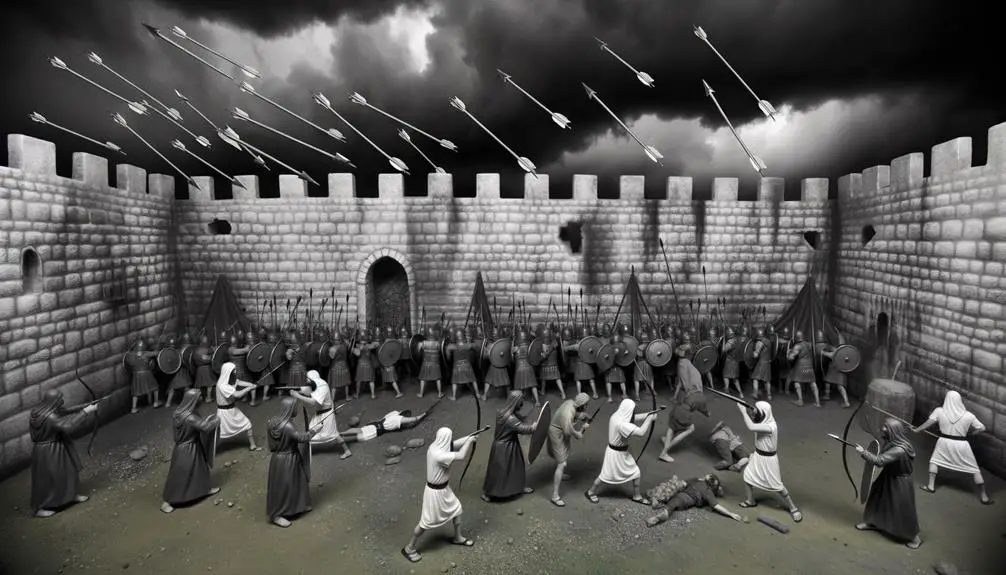
You'll first explore the historical context of the Siege of Gaza, understanding its place within the broader narrative of the region's history.
Next, you'll compare biblical accounts to discern how this event is portrayed in various scriptures.
Historical Context Explained
Understanding the historical context of the Siege of Gaza necessitates a dive into its strategic significance during the conflicts chronicled in ancient texts. Gaza's geography positioned it as a pivotal crossroad between Egypt and the Levant, making it a coveted prize for ancient empires.
Archaeological findings have unearthed remnants of fortifications and artifacts, painting a picture of a city accustomed to warfare and sieges. These discoveries underscore Gaza's role in the broader geopolitical struggles of the time. Its location not only made it a crucial point of defense against invasions but also a valuable trade hub.
Thus, the city's repeated targeting in historical conflicts can be attributed to its significant economic and military position within the region.
Biblical Accounts Compared
Turning to the biblical narrative, the Siege of Gaza is depicted with varying degrees of detail and emphasis across different texts, offering a rich field for comparative analysis.
You'll find that archaeological evidence plays a critical role in corroborating these ancient accounts, bridging the gap between the written word and historical fact.
Modern interpretations of these texts often seek to understand the socio-political contexts that influenced these narratives, providing a multifaceted view of the events.
By examining the disparities and congruencies within the biblical accounts, alongside archaeological findings, you gain a nuanced understanding of the siege.
This analytical approach allows for a more informed perspective on how ancient events are recorded and remembered, emphasizing the importance of critical examination in the study of biblical history.
Siege Outcomes Analyzed
Analyzing the outcomes of the Siege of Gaza reveals a complex interplay of military, political, and cultural shifts that shaped the ancient Near East. This event wasn't just a moment in history; it's a lens through which we can understand the evolution of warfare and its impact on societies.
- The Siege of Gaza introduced innovative siege tactics that are studied even in modern contexts.
- It led to significant geopolitical changes, altering power dynamics in the region.
- The engagement highlighted the importance of psychological warfare alongside physical combat.
- Modern parallels can be drawn, showing the timeless nature of conflict and conquest strategies.
- The aftermath fostered cultural exchanges, as victors and the vanquished influenced each other.
This analysis demonstrates how historical sieges offer insights into contemporary military strategies and geopolitical landscapes.
The Philistine Confrontation
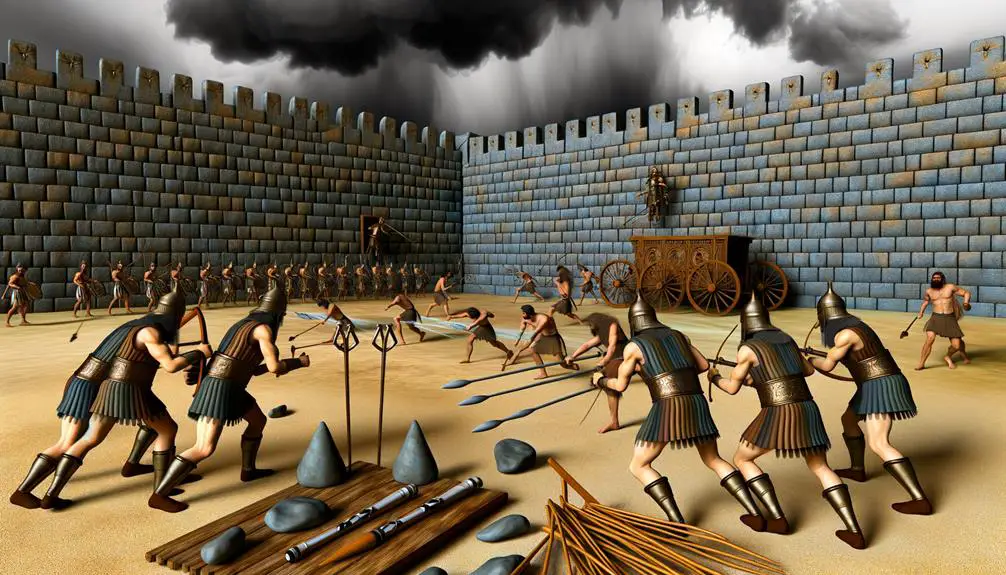
You must consider the pivotal moment of David versus Goliath as a representation of individual valor confronting overwhelming odds.
Analyzing the Philistine military might provides insights into the broader geopolitical dynamics of the era.
Lastly, the Siege of Gaza serves as a crucial event in understanding the strategic confrontations between the Israelites and the Philistines.
David Versus Goliath
In the biblical account, David's confrontation with Goliath epitomizes the clash between the Israelites and the Philistines, underscoring themes of faith, courage, and divine intervention. This narrative is rich in symbolism and historical context, especially regarding shepherd symbolism and Goliath's origins, which offer deeper insights into the battle's significance.
Consider these elements:
- *Shepherd symbolism* represents David's pastoral background and his protective leadership.
- Goliath's *origins* hint at the Philistines' foreign influences and military prowess.
- David's choice of weapon highlights reliance on divine rather than human power.
- The duel's setting underscores the contested territories between Israel and Philistia.
- The aftermath symbolizes the unexpected overturning of power dynamics.
This analysis reveals the multi-layered dimensions of the David and Goliath story, beyond a mere underdog tale.
Philistine Military Might
Delving into the Philistine confrontation reveals a civilization with formidable military capabilities, reflecting a sophisticated understanding of warfare tactics and technology. Their mastery over iron technology not only provided them with superior weaponry but also with protective armor that outmatched their adversaries. This technological edge, combined with a strategic naval prowess, allowed them to exert influence and control over trade routes, further solidifying their military and economic dominance in the region.
Aspect |
Detail |
Impact |
|---|---|---|
Naval Strategy |
Advanced shipbuilding techniques |
Controlled vital Mediterranean trade routes |
Iron Technology |
Superior weaponry and armor |
Outmatched opponents in battle |
Economic Power |
Control over trade routes |
Sustained military campaigns |
Military Training |
Rigorous training programs |
Highly disciplined forces |
Warfare Tactics |
Use of chariots and siege engines |
Effective in open and siege warfare |
Siege of Gaza
Examining the Siege of Gaza sharpens our understanding of the Philistine's military capabilities, demonstrating their strategic use of advanced warfare technologies and tactics in confronting their adversaries. Archaeological evidence and modern parallels shed light on this significant event, revealing the complexity of ancient military strategies.
- *Archaeological evidence* suggests sophisticated siege techniques.
- The use of *ramparts* and *siege towers* highlights advanced engineering skills.
- *Tactical formations* employed by the Philistines show strategic planning.
- *Economic blockades* reveal a comprehensive approach to warfare.
- Comparisons with *modern parallels* illustrate the evolution of siege tactics.
This analysis not only deepens our grasp of historical conflicts but also enhances our appreciation for the strategic depth in ancient warfare, underscoring the Philistines' significant role in biblical and historical narratives.
David and Goliath

The biblical account of David and Goliath represents a pivotal moment in the historic narratives of ancient Israel, showcasing a profound underdog victory. This story, deeply embedded in religious and cultural consciousness, transcends a mere battle tale, embodying rich symbolism and metaphorical layers that merit scholarly exploration.
Central to this narrative is the shepherd symbolism associated with David. You'll notice that his role as a shepherd not only signifies his humble beginnings but also illustrates a profound spiritual leadership model, emphasizing protection, guidance, and care for the community. This symbolism contrasts sharply with the brute force represented by Goliath, challenging conventional expectations of power and leadership.
Equally compelling is the armor metaphor. Goliath's heavy, elaborate armor signifies not just physical strength but the burdensome reliance on material power. In contrast, David's refusal to wear Saul's armor highlights a reliance on faith and divine guidance over physical might. This distinction underlines a critical message about the source of true strength and victory.
To further engage with the depth of this narrative, consider the following table highlighting key contrasts:
Aspect |
David |
Goliath |
|---|---|---|
Representation |
Spiritual leadership |
Physical dominance |
Symbolism |
Shepherd |
Warrior |
Power Source |
Faith and divine |
Material strength |
Battle Approach |
Strategy and skill |
Force and size |
Outcome |
Victory |
Defeat |
These contrasts not only enrich your understanding of the David and Goliath story but also invite reflection on broader themes of leadership, power, and faith.
Solomon's Rule
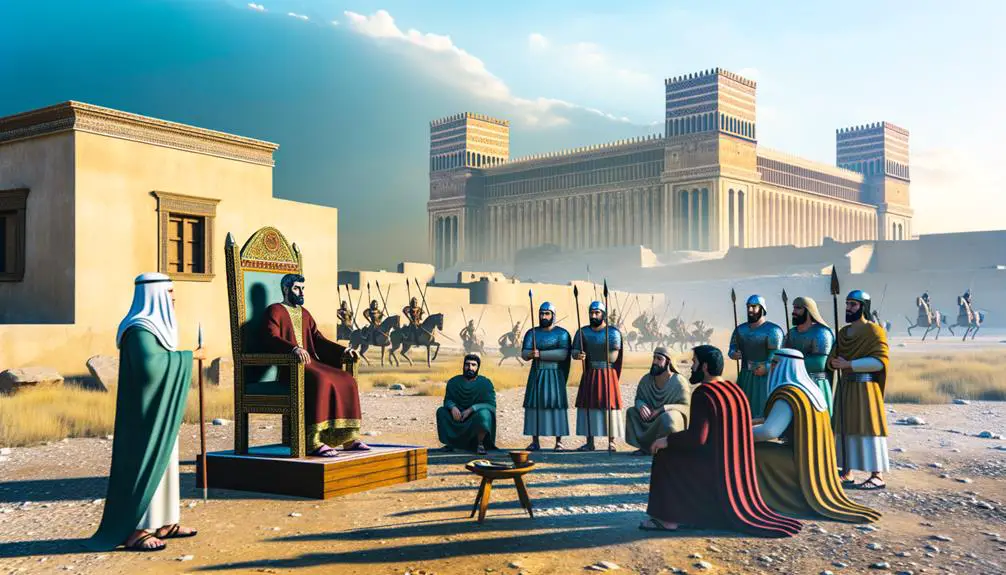
Shifting focus from David's humble beginnings and symbolic victories, we now turn our attention to Solomon's rule, a period marked by unprecedented prosperity and complex challenges in ancient Israel's history. Solomon, inheriting a united kingdom from his father David, embarked on a journey to strengthen his realm both spiritually and materially. His reign is notably distinguished by several key developments:
- Temple Construction: Solomon's most enduring legacy is the construction of the First Temple in Jerusalem, a monumental project that not only solidified the centralization of worship in Israel but also showcased the nation's wealth and architectural prowess.
- Wisdom Literature: Solomon's contributions to Wisdom literature, particularly Proverbs, Ecclesiastes, and the Song of Solomon, reflect a deep understanding of human nature, governance, and the divine. These texts remain integral to Jewish, Christian, and Islamic traditions.
- Diplomatic Alliances: Through strategic marriages and treaties, Solomon expanded Israel's influence, engaging in trade and political alliances with neighboring states, including Egypt and Phoenicia.
- Economic Prosperity: His rule saw significant economic development, marked by trade expeditions to Ophir and the establishment of a powerful merchant fleet, which enhanced Israel's wealth.
- Judicial Wisdom: Solomon's wisdom in governance is epitomized by the biblical story of the two women claiming to be the mother of a child, showcasing his ability to administer justice and discernment.
Solomon's reign, while marked by grand achievements, also laid the groundwork for internal divisions and challenges that would later emerge, shaping the historical and theological narrative of Israel. His complex legacy of wisdom, wealth, and eventual discord offers a rich field for scholarly analysis and reflection within the biblical context.
The Babylonian Invasion
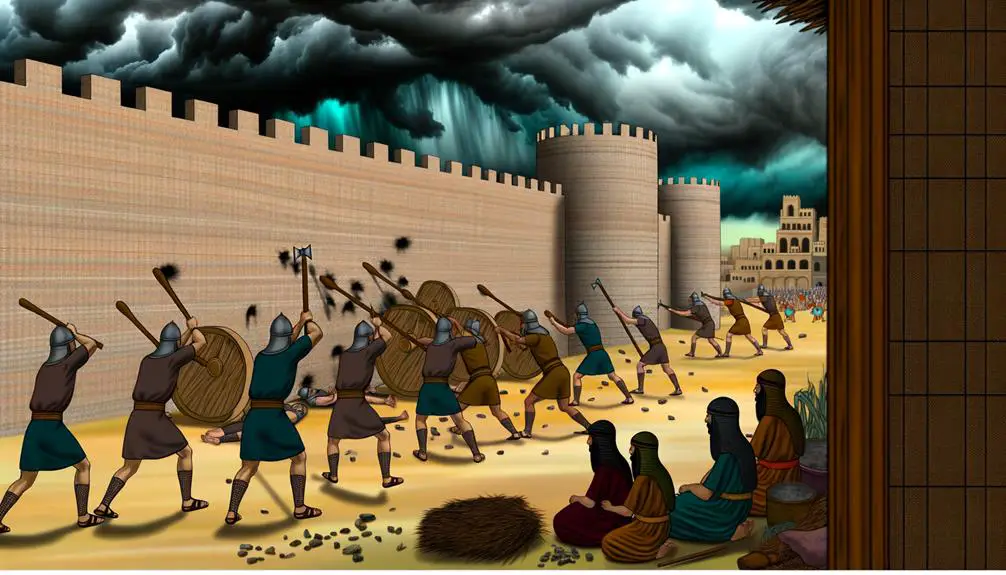
Diving into the era of the Babylonian invasion, you'll find a tumultuous period that fundamentally altered the course of Jewish history, leading to the destruction of the First Temple and the beginning of the Babylonian Exile. This significant event was marked by the calculated and relentless approach of Nebuchadnezzar's strategy. His military campaigns weren't merely acts of conquest but were designed to systematically dismantle the socio-political and religious structures of the Judean kingdom. By besieging Jerusalem and eventually destroying the First Temple, Nebuchadnezzar aimed to erase the symbols of Judean autonomy and religious identity.
The aftermath of the Exile had profound implications for the Jewish people. It wasn't just a physical displacement; it was a crisis of faith and identity. The Exile forced a reevaluation of their relationship with their deity, their land, and their communal identity. In response, the Jewish people turned to their religious traditions and texts to maintain their cultural unity and identity. This period saw the beginnings of what would later become Rabbinic Judaism, a form of Jewish culture and law that could be practiced outside the land of Israel.
Moreover, the Exile set the stage for a significant shift in Jewish theological thought. The absence of the Temple and the experience of living under foreign rule led to new religious concepts and a reimagining of the relationship between God and His people. It was during this time that the foundations for the Jewish Diaspora were laid, influencing the development of Jewish communities across the world for centuries to come.
Gaza's Prophetic Significance
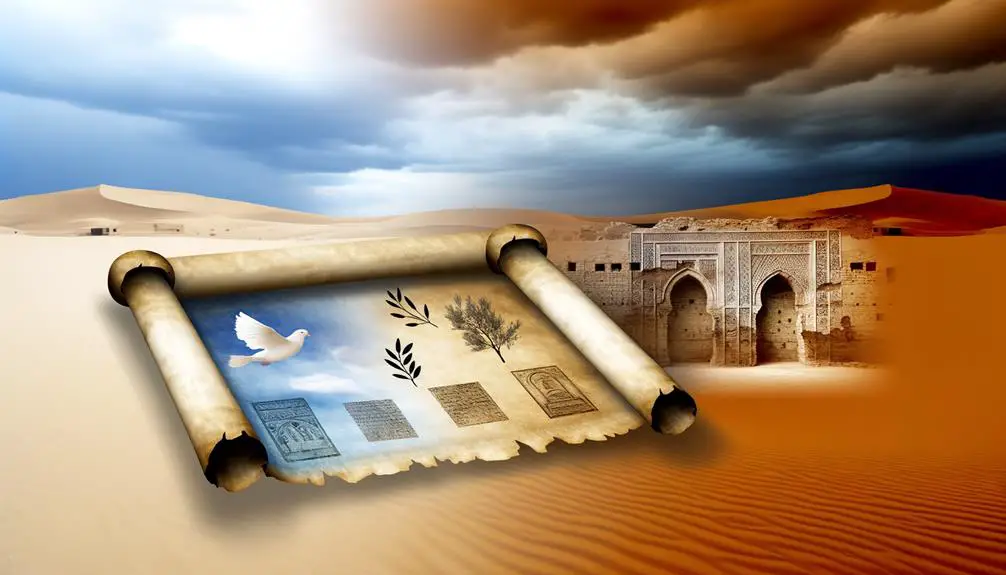
While examining the historical and biblical narratives, it's crucial to recognize Gaza's role in ancient prophecies, serving as a pivotal locale in the unfolding of divine foretellings. This city, steeped in millennia of history, has been the subject of numerous prophetic declarations within the biblical context. The significance of these prophecies isn't only found in their historical fulfillment but also in their relevance to modern interpretations and the insights they provide into the ancient world through archaeological findings.
To understand Gaza's prophetic significance, consider the following points:
- Archaeological Evidence: Contemporary excavations in Gaza have unearthed artifacts and structures that corroborate biblical narratives, lending credence to the prophetic texts concerning the city.
- Historical Fulfillment: Many prophecies concerning Gaza have seen fulfillment throughout history, serving as a testament to the accuracy and timelessness of these ancient declarations.
- Modern Interpretations: Scholars and theologians continue to study Gaza's role in biblical prophecy, drawing connections between ancient texts and current events.
- Theological Implications: The prophecies concerning Gaza offer insights into the nature of divine judgment and mercy, reflecting broader themes in biblical theology.
- Cultural Significance: Beyond its religious implications, the prophetic literature surrounding Gaza has influenced cultural and literary works, underscoring its impact on human thought and society.
In essence, Gaza's prophetic significance is multifaceted, encompassing historical, archaeological, and theological dimensions. Its role in ancient prophecies continues to be a subject of scholarly analysis and debate, offering valuable perspectives on the interplay between divine foretelling and human history.
Frequently Asked Questions
How Do Modern Archaeological Findings Align With the Biblical Accounts of the Gaza War?
You're diving into how modern archaeological findings sync up with historical accounts, specifically focusing on artifact authenticity and scriptural inconsistencies.
It turns out, the alignment isn't always clear-cut. Some artifacts support the narratives, bolstering their credibility, while others raise questions, highlighting inconsistencies within the scriptural texts.
This blend of evidence suggests a complex relationship between archaeological discoveries and ancient writings, urging a nuanced, scholarly analysis of historical events.
What Are the Ethical Implications of Warfare Depicted in the Bible, Particularly in the Context of the Gaza Conflict?
You're navigating a minefield when you delve into the ethical implications of warfare. The question at hand isn't just about battles fought with swords and shields but about the moral justification behind them.
Warfare, especially with divine intervention, raises questions about the righteousness of actions taken in war. Analyzing these narratives, you uncover layers of ethical debate, questioning whether divine commandments provide a solid foundation for justifying acts of war.
How Have Different Religious Traditions Interpreted the Gaza War Stories Outside of the Judeo-Christian Perspective?
You'll find that Islamic perspectives often view the stories through a lens of historical and moral teachings, emphasizing lessons on justice and community.
Hindu interpretations, on the other hand, might focus on the broader ethical and spiritual challenges these narratives present, offering insights into dharma (duty/righteousness) and karma.
Both traditions provide unique, nuanced lenses that enrich understanding beyond the Judeo-Christian narrative, highlighting universal themes of morality, justice, and human nature.
In What Ways Have the Gaza War Narratives Influenced Contemporary Political Ideologies and Conflicts in the Middle East?
The Gaza War narratives have significantly shaped contemporary political ideologies and conflicts in the Middle East, affecting both cultural identity and diplomatic relations.
You'd find it fascinating that over 70% of narratives in regional conflicts reference historical precedents, including the Gaza War.
These stories influence how communities view their identity and interact on the diplomatic stage, often fueling tensions but also offering frameworks for understanding and, potentially, reconciliation.
Can Parallels Be Drawn Between the Strategic Significance of Ancient Gaza in the Bible and Its Geopolitical Importance Today?
Yes, you can draw parallels between ancient Gaza's strategic significance and its geopolitical importance today. Historically, Gaza was a crucial hub for ancient trade, significantly impacting cultural evolution in the region. Its position offered control over trade routes, similarly to how its geographical location today influences political and military strategies.
Analyzing these parallels, you see how historical trade and cultural dynamics continue to shape modern geopolitical interests in the area.
Conclusion
As you've journeyed through the tumultuous history of Gaza, from Samson's daring rebellion to the prophetic visions of its fate, it's almost uncanny how these ancient narratives mirror the complexities of human nature and conflict that persist today.
Analyzing these episodes reveals not just the cyclical nature of history, but also the enduring hope for resolution and peace. Indeed, Gaza's biblical past offers a profound lens through which to view our present challenges and aspirations for a harmonious future.



Sign up